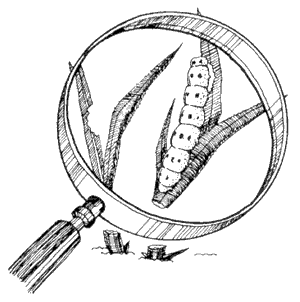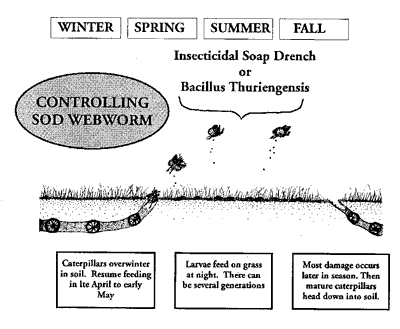Identifying Sod Webworms
 |
In their caterpillar stages, sod webworms (Crambus species) are serious pests of lawn grasses. The caterpillars are about 3/4 to 1 inch long. They have dark shiny brown heads, but their color varies from greenish to beige, brown or gray, depending on the species. They have 4 parallel rows of distinctive dark spots along the length of their abdomen. Long, stiff hairs protrude from these spots.
The adults are buff-colored or grayish-brown moths with a wingspan of about an inch. They fly in the early morning or late evening in a jerky zigzag pattern, just a few feet above the lawn, which explains another common name for these pests, “lawn moths.” They fly up from their hiding places when tall grass is mowed or shrubbery is disturbed. They are also attracted to lights at night. Sod webworms are found throughout the United States and in southern Canada.
Their Growth Stages
 |
Sod webworm moths don't feed on lawn grasses, but they drop their eggs into the grass as they fly. After 6 to 10 days, the eggs develop into very hungry caterpillars. These immediately begin feeding on grass blades, and are active only at night. As they feed, they build silk-lined tunnels in the thatch near the soil surface. During the 35 days or so that the webworm lives as a caterpillar, it can eat about 4 square feet of grass.
By late fall the webworms are nearly mature. They overwinter curled up in the soil as pupae and emerge as moths in the spring to begin feeding and laying eggs as soon as the soil temperature rises--in late April to early May in Northern and Midwestern states. First generation larvae feed from late June to the end of July. The second generation can be a more serious problem because the host grasses are usually dormant or under stress and can't replace damaged foliage. In the warmer areas of the country, webworms may produce up to 3 generations, during May, July, and September. In Western and Southern states, webworm generations may overlap, with all life stages--eggs, caterpillars and moths—present in the lawn at the same time.

